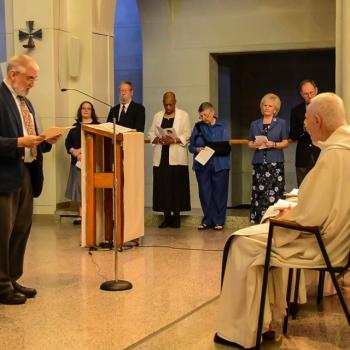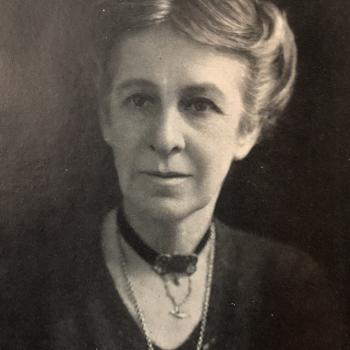A Book for All Time: Why Evelyn Underhill’s Mysticism Still Matters
For pretty much my entire adult life, if anyone would ask me who my favorite authors are, without hesitation I would say Evelyn Underhill and Thomas Merton. To me, the work of Evelyn Underhill represents the call for the revival of mysticism in our time, while Merton anchored the call to mysticism in the urgent political and social concerns that shape life in America over the last fifty years or so.
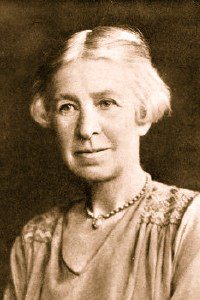
As a woman and a man, a layperson and a monk, an Anglican and a Catholic, Underhill and Merton together offer a rich, almost stereophonic invitation to the contemplative life for our generation. Of the two, Merton is by far the more well-known author, at least here in America. But for now, let’s set Merton aside. I’d like to tell you a little bit about my relationship with the writings of Evelyn Underhill and with the spirituality that they point to. I’m doing this not because my story is particularly interesting — it’s not — but in the hopes that you might be inspired to fall in love with Evelyn Underhill, and with Christian mysticism, yourself.
When I was eighteen years old, I had a dream about the end of the world. It was filled with plenty of dramatic imagery: the sky grew dark at midday; a silence descended over the world, and one by one the stars fell from the sky. The imagery probably came into my mind from the last volume of the Chronicles of Narnia, as I was reading those books that summer; the emotional content of the dream was no doubt driven by the fact that I had just graduated from high school and were about to leave home for college, so in a very real sense my world really was coming to an end.
While I can easily explain away the psychology of this dream from the safe remove of thirty years’ time; when the dream occurred it was raw, visceral, and frankly, frightening. The next morning, rattled by how vivid and real —or, should I say, unreal — the dream felt to me, I turned to a trusted older friend, a former organist from my church. David was what my parents rather dismissively referred to as a hippie — despite being a church organist, he had shoulder length hair, still rather scandalous in small-town Virginia in the 1970s. He played Bach and Wesley for a living, but his own taste in music ran rather toward John Coltrane and Jimi Hendrix. As for his faith convictions, he was a Unitarian, and so he was just as likely to talk about the Buddha or Krishna as Jesus Christ or Saint Paul.
I went to David’s house and told him about my unsettling dream. He listened intently like any good friend would, and then said he had a book he thought I would like to read. He rummaged through on overstuffed bookcase until he pulled out a thick little paperback book with an hideously unattractive cover. He told me I could have the book, and I still have it today, one of my prized possessions. It is, of course, Evelyn Underhill’s Mysticism.
How Mysticism Changed My Life
I know to say “a book changed my life” is almost a cliché, but in my case, yes, Underhill’s Mysticism changed my life. It did so in two ways. First, it gave me a language for spiritual experience that was not anchored in either Pentecostalism or secular psychology, which were the only two models for the inner life available to me at the time. That was helpful enough. But even more to the point, Underhill introduced me to the great mystics of the past, and in doing so performed a valuable function: she helped me to discover the chain of spirituality that extended from Biblical times to the present day. Growing up a Protestant in the American south, my religious education suffered from a significant defect: the 1500 year period that extended from the close of the New Testament to Luther nailing his 95 theses on the church door in Wittenberg was never discussed.
It’s as if Christianity were frozen in time for a millennium and a half, except that by Luther’s time those pesky Catholics were up to all sorts of mischief, like selling indulgences and making everybody believe in purgatory. Along came Luther and swept all that trouble away — but it was up to Evelyn Underhill to help me see that those fifteen centuries were not just an extended Dark Ages, but rather teemed with a vibrant tradition of spirituality and the quest for communion with God — and those who were at the forefront of this quest are whom we now celebrate as mystics.
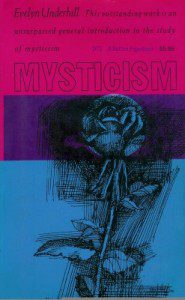
The words “mystic” and “mysticism” are troublesome words, contested by Christians on either side of the Reformation divide. The Reformation, at its heart, is an argument about authority, with Catholics defending the absolute authority of the church against the Protestant argument for the supreme authority of scripture. In the midst of that dogfight, mysticism — with its emphasis on the authority of personal experience, an authority that is by its nature decentralized and not conducive to ecclesiastical obedience — soon fell under suspicion on all sides. The rise of modernity and the scientific way of thinking about the cosmos and anthropology marginalized mysticism even further.
Evelyn Underhill realized this, and if one looks at all her books chronologically, we can see that the more deeply she became immersed in the life of the Church of England, the more she replaced language of “mysticism” with the far less threatening alternative of “spirituality.” Indeed two of her most accessible books clearly reflect this: Practical Mysticism was published in 1914, and offers an approach to mystical prayer for “normal people,” which is to say those of us who are not clergy or monastic; whereas in 1937 a similar short and accessible book, drawn from several radio talks Underhill gave, was called The Spiritual Life.
How shall we understand the difference between mysticism and spirituality? Aside from the obvious etymological distinctions — one word reminds us that God is the ultimate mystery, while the other points to the Third Person of the Trinity — I think the case can be made that mysticism is a subset of spirituality. All mysticism, at least all Christian mysticism, is spiritual, but not all spirituality is mystical. Underhill defines the spiritual life as “soaked through and through by a sense of His reality and claim, and self-given to the great movement of His will.”
In other words, spirituality can be anchored in faith rather than in the necessity of experience, and it is oriented toward conformity with God’s will rather than communion with God’s nature. This may seem to be splitting hairs, but I think it is important for a number of reasons. Some people find mysticism intimidating, while others are uncomfortable with its emphasis on such things as darkness as unknowing. Karl Rahner may have been right when he insisted that the Christian of the future must be a mystic in order to exist, but I think in the economy of God’s love, many Christians will choose to walk a lowly path of spirituality before being called to the higher mountains of mysticism.
By orienting herself toward spirituality in her maturity, Underhill did not repudiate the important work she did in making mysticism accessible and attractive to a modern audience; rather, she continued to support mysticism by inviting her readers to take the all-important first steps of embracing spirituality in a broad and general sense.
Evelyn Underhill died 30 years after the publication of Mysticism, which means this June will make the 70th anniversary of her passing. In those 70 years the church has seen a veritable explosion of interest in the spiritual life. Underhill’s work bore fruit in the continued growth of interest in key mystics like Julian of Norwich, The Cloud of Unknowing, Meister Eckhart, Teresa of Avila, and John of the Cross. The very same year that Underhill died a young man from New York entered Gethsemani Abbey in Kentucky, and when his autobiography was published seven years later, Thomas Merton became what in our time we might call a “rock star mystic” — a spiritual writer whose vision and authority was met with worldwide celebrity.
Meanwhile, other visionaries were beginning to connect the dots between spirituality and other areas of inquiry: Teilhard de Chardin looked at the relationship between mysticism and science; Dorothy Day articulated a political vision informed by the Catholic faith; the Second Vatican Council encouraged an entire generation of both Catholic and Protestant seekers to study the ancient writings of key Christian thinkers, including the mystics; and Merton himself was among the first of several important writers who began to explore the possibility of fruitful engagement between Christian spirituality and the wisdom of other faiths. Within a few short decades of her passing, Evelyn Underhill’s legacy had blossomed into an extraordinary rebirth of spiritual hunger, not only among “professional” Christians but even, and especially, among the laity.
To what extent did Underhill contribute to the spiritual renaissance of our time? Did she influence it, or merely anticipate it? Perhaps there is no real way of answering this question. We know that Merton was familiar with her work, C. S. Lewis was a fan of hers, and that even the hippie mystic Alan Watts acknowledges her place as an authority on the mystical life. But Underhill was a laywoman, affiliated with no religious order; she never held a faculty chair, and left behind no movement, institution or organization. Her influence, while amplified by the ongoing success of her writing, is really not so different from how most of us live out our calling to “Divine fecundity” — she quietly influenced those who knew her, who corresponded with her, who encountered her through her words. In other words, her legacy is a humble and quiet one. And given how knowledgeable and, I believe, advanced she was in her own mystical practice, I suspect that is just how she would have wanted it.
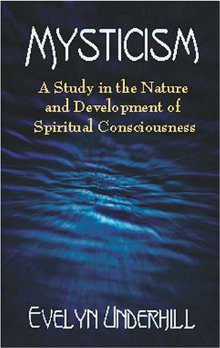
Seven Ways to Think About Evelyn Underhill
What I’d like to do now is to suggest seven ways that we can think about Evelyn Underhill and her legacy for our time. I hope that if you are not familiar with Underhill’s writing, that you will purchase a book or two of hers and use them as part of your personal devotion. These seven dimensions of Underhill’s legacy might help you to approach her, in a way that might particularly speak to you. For me, all seven of these ways of thinking about Underhill matter. I suspect that the more you read Underhill, the more you will find value in each of these approaches as well.
- Evelyn Underhill as initiator — she ushers us into the mysteries.
If we trace the concept of mysticism back to its origins among the pagan Mystery Religions of ancient Greece, Rome and Egypt, we see that an essential concept related to the mysteries is initiation, or being ushered into a new dimension of spiritual reality. Christianity has its own rite of initiation — baptism, and to a lesser extent, confirmation. Initiation means to be brought into something new, and in terms of Christian mysticism, this means a new depth and reality to our relationship with God. Throughout her long and prolific career as a writer, spiritual director, and retreat conductor, Evelyn Underhill devoted her entire ministry to helping others undergo this kind of spiritual initiation. For me, reading Mysticism when I was 18 years old meant being ushered into an entirely new way of understanding the love of God and how God can make a difference in our lives, and it is not overstating the case to say that this “initiation” changed my life.
- Evelyn Underhill as inspiration — her writing is elegant and lovely.
Evelyn Underhill is a writer’s writer. Her books are a delight to read, for her style, while at times showing the limitations of the formalism of her generation, is for the most part limpid yet poetic, erudite yet accessible, intelligent yet never burdened by an excessive cerebralism or academic stuffiness. Although part of the delight of Mysticism lies in how generously she quotes from an astonishing number of the classic mystics, the quotations she selects are always both relevant to the point she is making and interesting in their own right, marking her as a brilliant editor as well as writer. It is rare to find an author whose work simultaneously appeals to the scholarly community as well as the general public, and the fact that Underhill found respect both as an invited lecturer at Oxford as well as a popular retreat director speaks not only to the importance of her message but her skill in delivering it.
- Evelyn Underhill as spiritual director — she teaches the path of discipleship.
One of the most important dimensions of authentic Christian spirituality is that it is relational and communitarian in nature. As Christians, it is knit into our DNA to care for one another, nurture each other, and bear one another’s burdens. Underhill exemplifies this in both her public and private writings. While she is an advocate for mysticism and spirituality, she never diminishes her message by resorting to mere boosterism. She is always careful to point out the potential dangers, snares, and blind alleys that can derail the spiritual life at any stage along the journey. She brings an astute, perceptive understanding of topics that we often are not very comfortable considering: such as sin and the human tendency to reject or resist what is best for us. For Underhill, the spiritual life is never just a cozy cuddle-party with God; it is always a demanding challenge to let the Spirit completely remake us according to the stern yet beautiful demands of love.
- Evelyn Underhill as soul friend — her warmth and optimism are encouraging.
Perhaps I am repeating myself, for what is a good soul friend but a spiritual director? But there is a subtle difference here, and my point is that Underhill embodies both the most challenging demands of a classically stern spiritual director, but also the warmth, familiarity and gracious encouragement of a dear spiritual friend. Her letters are particularly instructive here, for it is in those personal and often informal missives that we catch a glimpse of the affection and kindness that she brought to bear on the many people who turned to her for spiritual guidance. Because of her keen awareness that, for Christians, the Holy Spirit is the only true director of souls, she brought a sanity, a sense of proportion, and even a sense of joy and humor to her work helping others to grow in grace.
- Evelyn Underhill as mystical historian — she reveals the tradition to us.
Part of what makes Mysticism such a delight to read, and continually relevant today, is the wealth of direct quotations from mystics throughout the history of Christianity. Underhill quotes over 100 different mystics — a stunning achievement in its own right. Clearly, she worked hard to grasp the rich history of mysticism as part of her research to write about this topic. Thankfully, this means that reading Underhill — especially Mysticism, but also her 1925 work The Mystics of the Church — is to be ushered in to a literary museum in which the history of experiential Christian spirituality comes vividly to life. Underhill understood not only how mysticism evolved over time, but also what made each of the many Christian mystics special and unique. She honestly assesses which mystics are truly great, and which ones made lesser contributions, and she understands that every individual mystic is a unique personality, which means that she often would point out the unique, charming, or even oddball characteristics that sets each individual mystic apart. History can be a dry and dull topic in the hands of a mediocre writer, but with Evelyn Underhill, the treasures of the past come vividly to life.
- Evelyn Underhill as artist — she clearly understood beauty as a central category of the spiritual life.
Underhill recognized that the Platonic categories of goodness, truth, and beauty are essential elements of authentic Christian spirituality. But where theology is the discipline concerned with truth, and ethics explores the question of goodness, the heart of spirituality as lived experience is very much a quest for the beauty of God. That she understood this is clear when we consider how important art itself is to Underhill’s explanation of mysticism. She repeatedly stresses that artists are those who come the closest to understanding and living the contemplative life, and so it is not surprising that she repeatedly uses illustrations from the world of art to explain and illuminate the mystic way. To be a mystic is to be an artist, working not with paint or words or music as one’s medium, but with the soul itself. The beatific vision is the vision of ultimate and eternal beauty, and in her writing and her thinking, Underhill repeatedly commends such beauty to those who would follow her on the mystical journey.
- Evelyn Underhill as peacemaker — the culmination of her life’s work was to take a stand for nonviolence as a central mandate of the Christian life.
“My peace I leave with you,” Christ promised his followers. At the summit of her life’s journey, Evelyn Underhill took the courageous and risky path of affirming this aspect of the Christian faith, even in the midst of the beginning of World War II. After a lifetime of studying not only the gospel but the witness of saints like Francis of Assisi and Julian of Norwich, Underhill came to the recognition that Christianity is a path of reconciliation, not aggression. She stood for peace quietly but firmly, and as such can be an inspiration for anyone who wishes to follow the Prince of Peace, even in an environment that seems wholly ordered toward war.
Reflecting On Underhill’s Legacy
I’d like to conclude by sharing with you just a few thoughts on Evelyn Underhill’s legacy, by pondering this question: why does mysticism, and specifically Christian mysticism, matter today? After one hundred years, does it still make sense for us to read Underhill’s book on this topic, not just as an academic exercise, but as a means of nurturing our soul?
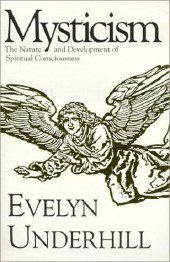
I can only answer this question with as enthusiastic a “Yes” as possible. Mysticism matters, because here in the twenty-first century, mystery matters. Over the last century we have seen the emergence of the postmodern world, thrown into being by its birthpangs at Hiroshima and Nagasaki and given a framework of meaning through the internet and the triumph of media. When Mysticism was published, the great threat to society was war, as exemplified by the horrors of the Great War, or what we now call World War I. Fifty years later, “threat” was understood in ideological terms: in the west, we felt most threatened by communism. Today, our primary threat is terrorism, which brings to mind those words of Franklin Delano Roosevelt: the main thing we have to fear is fear itself.
But as our world has grown smaller and our sense of what threatens us has become more abstract, we who identify as Christians have discovered that our world view is only one among many, and that other ways of seeing and understanding the cosmos deserve our consideration, if not our respect. A mere fifty years ago, when Thomas Merton began studying zen, this was thought of as idiosyncratic, if not heretical. But today, interreligious dialogue is becoming increasingly widespread not only among theologians and church leadership but indeed among ordinary clergy and laypersons like you and me. Here in Atlanta, for example, we have a vibrant interfaith community in which events regularly occur drawing not only Christians but Muslims, Jews, Vedantists, Buddhists, and adherents of other faiths. Christianity in the twenty-first century is now a faith that, for the first time really, has to learn how to be a good neighbor.
Meanwhile, the world of science continues to impact the way we understand theology. Sometimes this is a hostile encounter, as exemplified by the critique of religion by “celebrity atheists” like Richard Dawkins or Christopher Hitchens. But others, from Pierre Teilhard de Chardin to Raimon Panikkar to John Polkinghorne, offer a more friendly conversation in which the empirical truth of science and the revelation and theological tradition of Christianity come together, but leaving neither unchanged. At its worst, science insists that Christianity be limited to a system of moral and ethical inquiry. But at its best, the dialogue between science and religion brings us to the frontier of human knowledge and understanding, where the propositional declarations of our faith shade off into the mystery of unknowing, where God is no longer a philosophical problem to be solved, but an ineffable presence to be encountered — and loved.
So in a time when Christianity must be a good neighbor to the great faiths of the world, on the one hand, and to the splendors of natural science on the other, the old catechisms suddenly seem shrill and inadequate. I don’t know many Buddhists or educated atheists who are going to be swayed by Campus Crusade’s Four Spiritual Laws. But in the challenges of our time, we Christians have essentially three choices: we can abandon our faith, which as we know many of our brothers and sisters are doing. We can retreat into a reactionary fundamentalism, but I suspect I do not need to detail the many reasons why this is a fundamentally unsound option. But if we neither abandon our faith nor armor ourselves with a naïve anachronistic theology, we are left with the invitation that Karl Rahner issued some thirty years ago: we are invited to become mystics.
Embracing Mysticism Today
We are invited to join in the work of people like Ken Wilber and Father Thomas Keating, a Buddhist-influenced philosopher and Trappist monk who explore the relationship between contemplative practice, interfaith dialogue and the science of human consciousness. We are invited to join in the work of Benedictine and Cistercian leaders like Mary Margaret Funk and David Steindl-Rast, who under the auspices of the Monastic Interreligious Dialog have engaged in meaningful dialogue with contemplatives from other faith traditions. Even here in Atlanta, there is Ben Campbell Johnson, who after a distinguished career as the professor of Christian Evangelism at Columbia Theological Seminary discovered the riches of the contemplative tradition, which immediately impelled into a new career as a leader in the interfaith community here in our own town, engaging in numerous programs designed to bring Christians and the members of other faith communities together.
I’m not suggesting that contemplation is necessarily linked to interreligious dialogue; that is a personal passion of mine, so naturally it is something I would highlight. But my point is that contemplative practice, with its roots deep in the history of Christian spirituality and yet with a thoroughly contemporary emphasis on mystery, unknowing, the love of God, the practice of silence and listening, and a faith grounded in optimism, community and reconciliation, is a dimension of Christian spirituality uniquely appropriate for the needs and demands of our time. Evelyn Underhill’s Mysticism matters because we need a spirituality grounded in mystery and contemplation now more than ever.
So I hope that you will consider Evelyn Underhill’s invitation to explore the rich history and contemporary practice of experiential spirituality, not merely as an interesting footnote in the history of twentieth century Anglicanism, but as a meaningful invitation for all of us today. Underhill understood that there is a great diversity in the world of Christian spirituality and mysticism. For some, the life of prayer means a rich, almost sensual experience of falling in love with the Source of Love. But for others, it is a profound and mysterious journey into the farthest reaches of consciousness, into a realm of darkness, unknowing, uncertainty, and doubt that can only be navigated by the most vulnerable type of faith. Is mysticism the sacred marriage as described in the Song of Songs? Or a silent, dark, almost agnostic experience of meditation, like what is documented in The Cloud of Unknowing? Underhill understood that mysticism is both these things, and much more. That here is diversity in the heart of God and in the practice of Christian spirituality.
There is no one right way to be a mystic or a contemplative. But the important thing is to step out, in the mystery, and begin the journey. A Carmelite friar named William McNamara, writing in the 1980s, said “The mystic is not a special kind of person; each person is a special kind of mystic.” Evelyn Underhill would have understood this, and agreed with him. So for you and me, here in the opening years of the third millennium, mysticism represents an invitation to find our unique and true identity — in God. Like Julian of Norwich, Teresa of Avila, Thomas Merton, Meister Eckhart, John Ruysbroeck, and many others, Evelyn Underhill speaks to us from the past, but offers timeless wisdom that can illuminate and even transform our spiritual lives today.
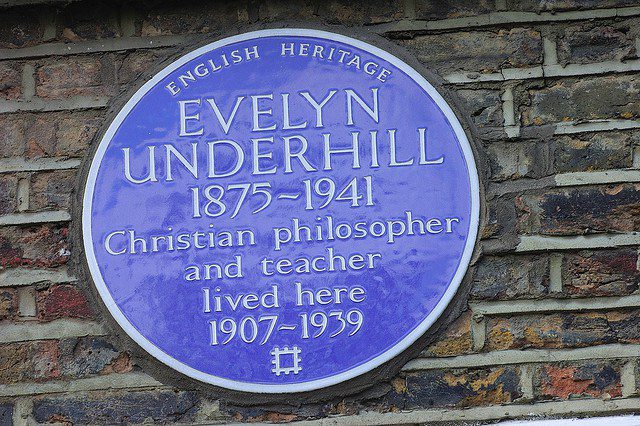
This paper, in a slightly different form, was first presented at the Evelyn Underhill Conference sponsored by the Episcopal Diocese of Atlanta’s Institute for Ministry and Theological Education, February 19, 2011, to mark the 100th anniversary of the publication of Underhill’s Mysticism. To purchase a copy of the book, click here. Or, click here to purchase it for your Kindle.
Enjoy reading this blog?
Click here to become a patron.







